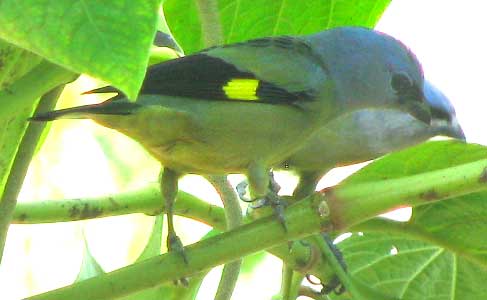Excerpts from Jim Conrad's
Naturalist Newsletter
from the January 24, 2010 Newsletter issued from Hacienda Chichen Resort beside Chichén Itzá Ruins, central Yucatán, MÉXICO; limestone bedrock, elevation ~39m (~128ft), ~N20.676°, ~W88.569°
YELLOW-WINGED TANAGERS
One morning as I stood washing my clothes in the outside lavatory near the orchard, two dark, oriole- size birds caught my attention rushing from the shadows of one tree to another, sticking together like mutually enamored teenagers unable to get enough of one another's presence. In the shadows they looked like black birds with small, yellow patches on their wings. The yellow wing spots -- the "broad yellow flash across base of remiges," as Howell describes them -- were enough for an ID. They were Yellow-winged Tanagers, THRAUPIS ABBAS and you can see the pair perched in an Hoja Santa, Piper auritum, with the foot of one bird wrapped around the leg of another, below:

Northerners who know only the Scarlet, Summer, Hepatic and Western Tanagers might harbor the notion that tanager colors are limited to red, yellow and black. But North America's four tanager species are just the tip of the tanager iceberg, since the Tanager Subfamily, the Thraupinae, is mainly Neotropical -- mostly occuring in the American tropics. Mexico is home to about 30 species that come in lots of gaudy colors. In the world of tanagers, the Yellow-winged's lilac-blue head and lemon-olive underparts aren't particularly unusual.
Adapted to disturbed areas such as plantations, weedy forest edges and such, Yellow-winged Tanagers are fairly common in Mexico's southeastern lowlands, though the Yucatan's northern coast is too arid for them. We're nearly at their northernmost boundary here. The species is distributed south to Nicaragua.